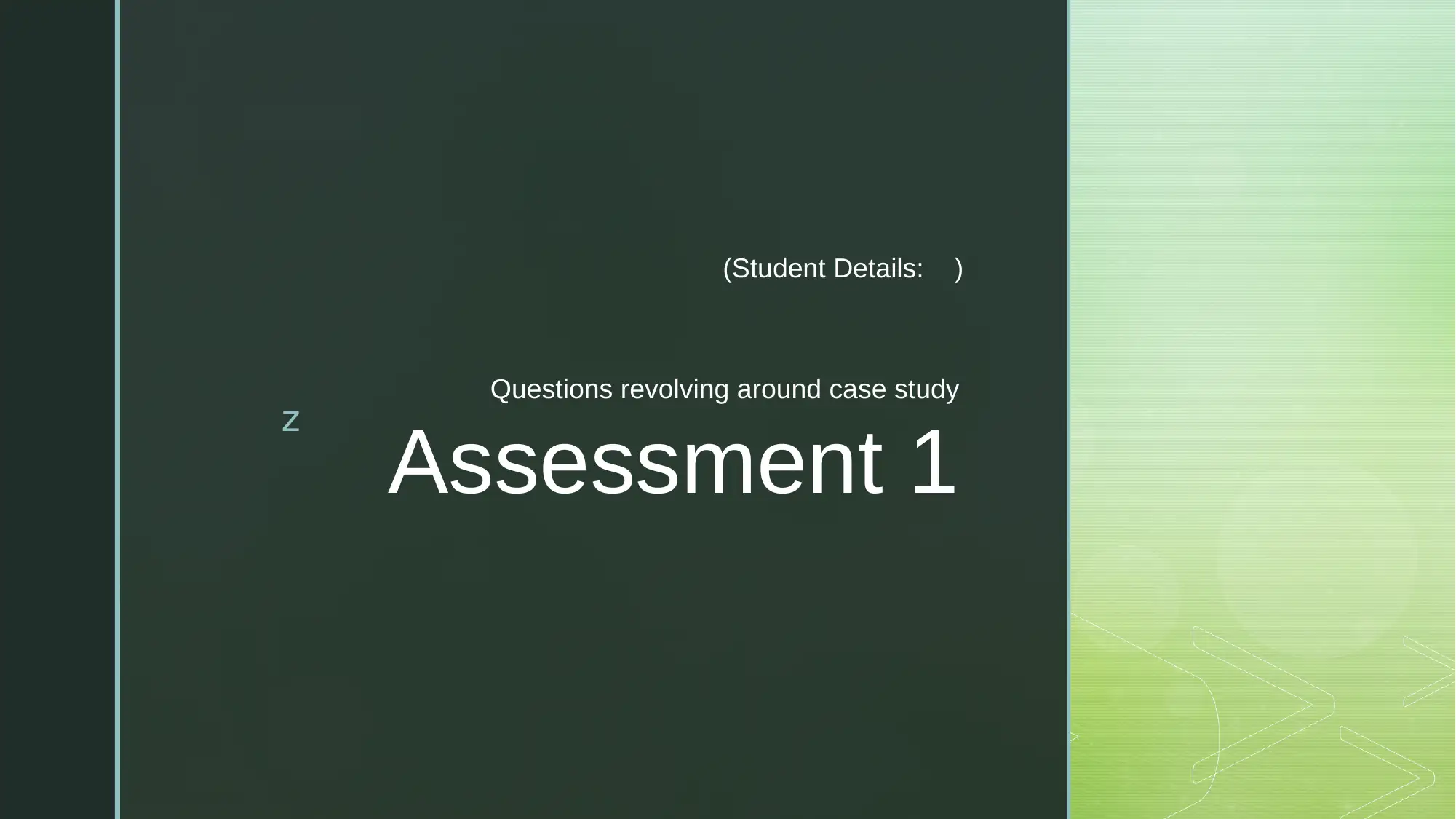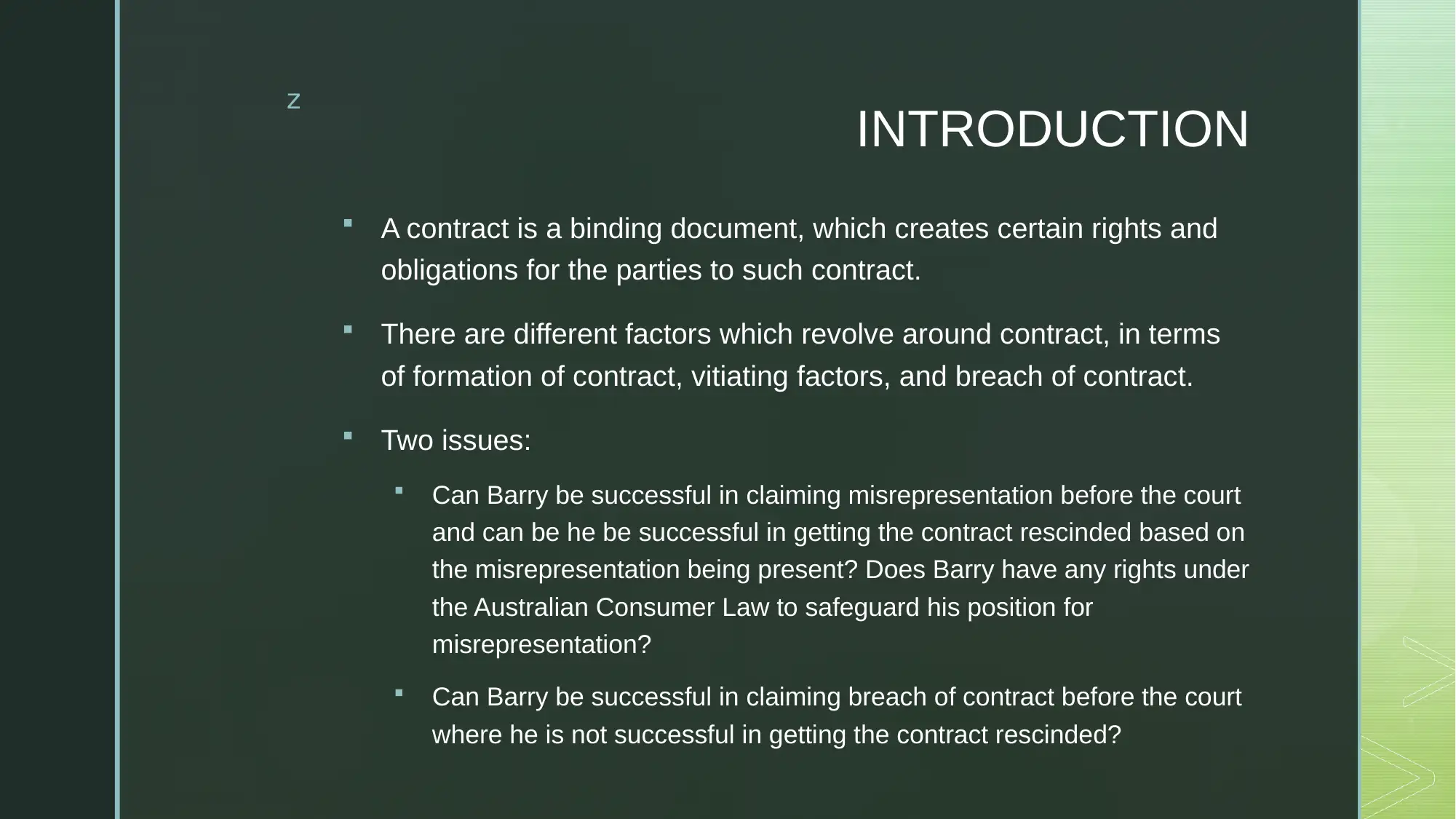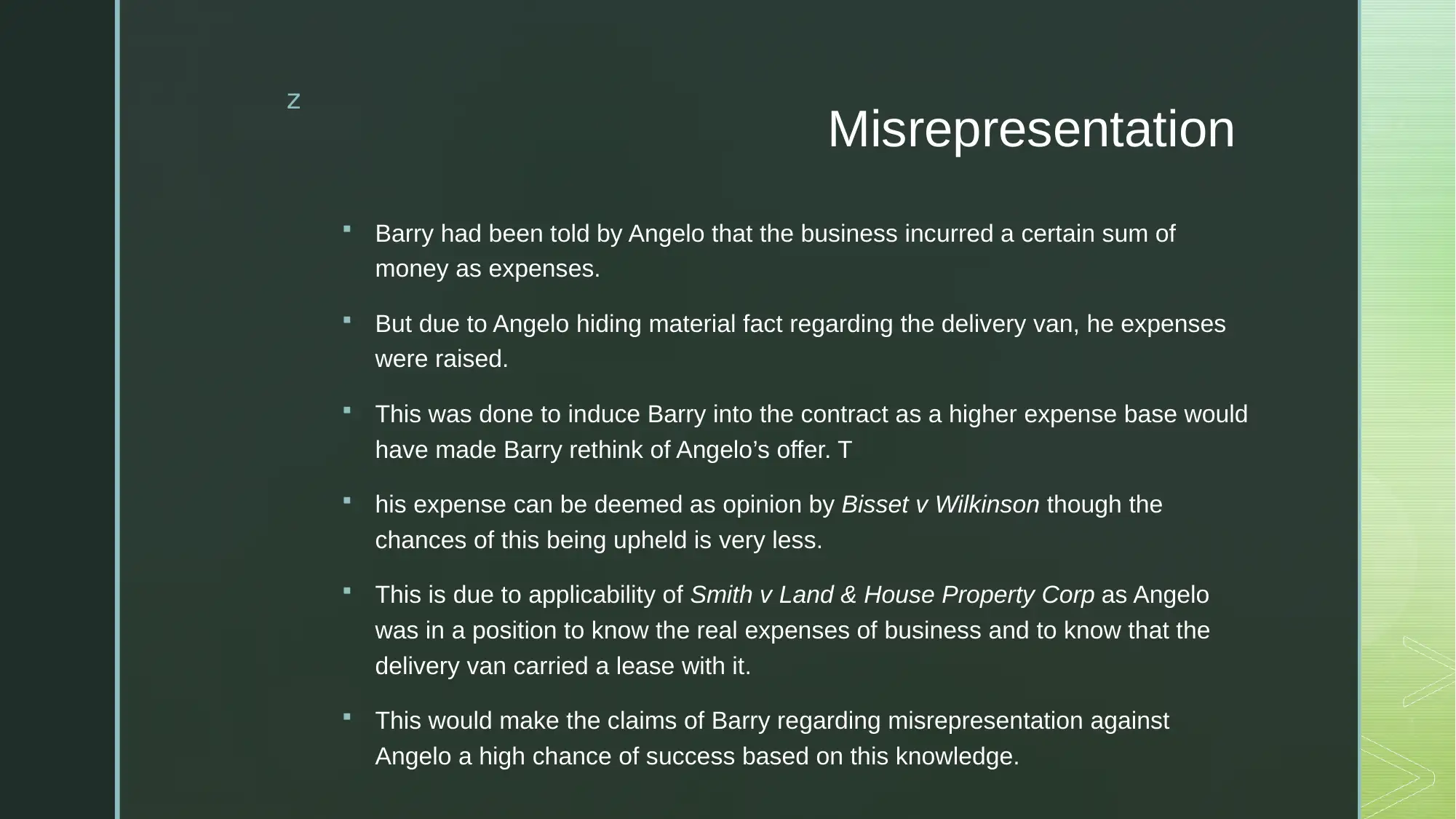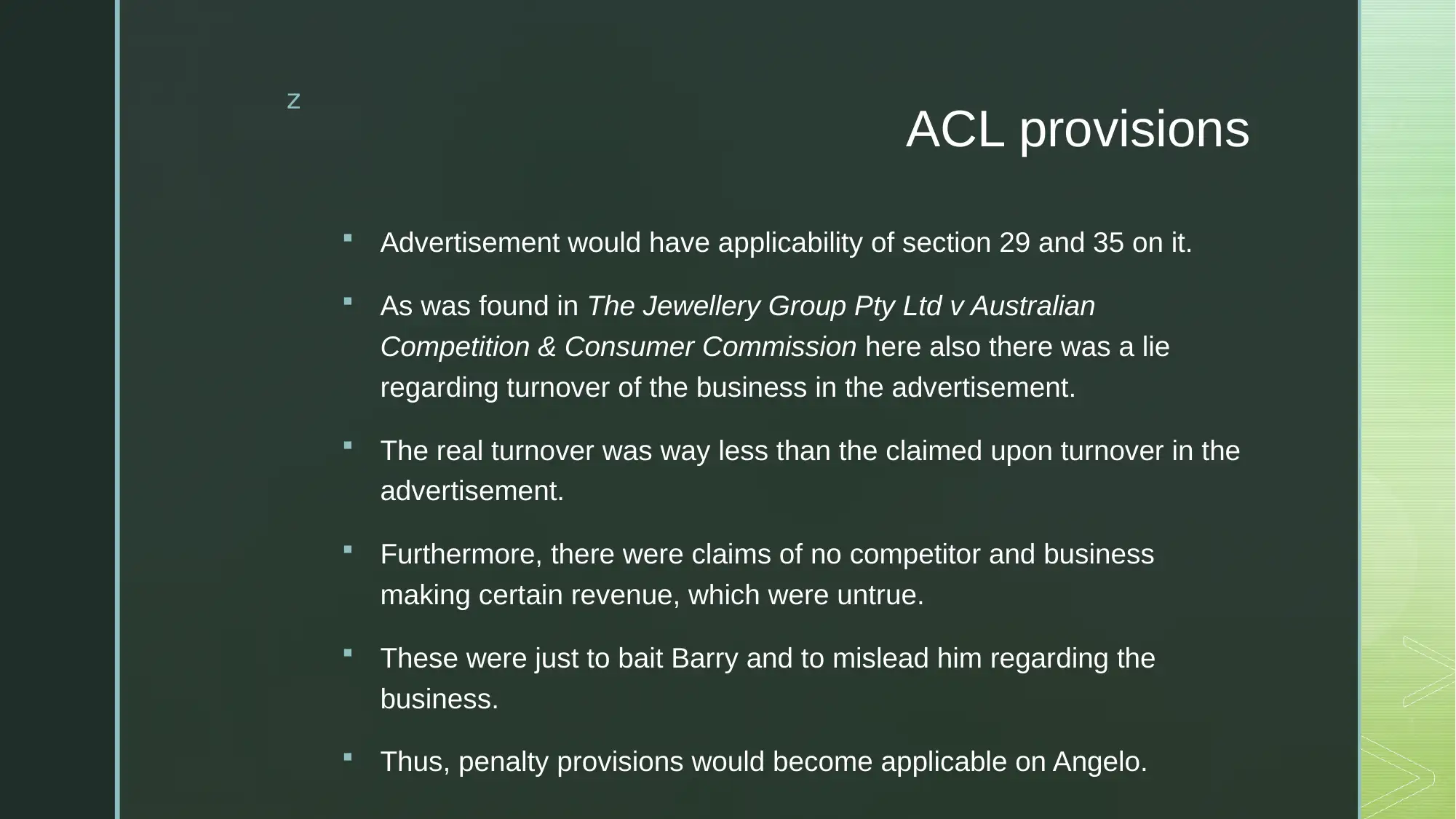Case Study: Misrepresentation and Breach of Contract in Contract Law
VerifiedAdded on 2021/06/17
|7
|738
|47
Case Study
AI Summary
This case study analyzes a contract law scenario involving Barry and Angelo. It examines the issues of misrepresentation and breach of contract, focusing on whether Barry can successfully claim misrepresentation, seek contract rescission, and pursue remedies under the Australian Consumer Law. The analysis covers the concept of 'invitation to treat' in advertisements, the potential for misrepresentation regarding business expenses and turnover, and the breach of contract concerning the delivery van and loader condition. The document concludes with legal advice on the potential outcomes for Barry, highlighting his chances of success in claiming remedies under both common law and statutory law, including penalty provisions for misrepresentation and claims for breach of contract.

z
Assessment 1
Questions revolving around case study
(Student Details: )
Assessment 1
Questions revolving around case study
(Student Details: )
Paraphrase This Document
Need a fresh take? Get an instant paraphrase of this document with our AI Paraphraser

z
INTRODUCTION
A contract is a binding document, which creates certain rights and
obligations for the parties to such contract.
There are different factors which revolve around contract, in terms
of formation of contract, vitiating factors, and breach of contract.
Two issues:
Can Barry be successful in claiming misrepresentation before the court
and can be he be successful in getting the contract rescinded based on
the misrepresentation being present? Does Barry have any rights under
the Australian Consumer Law to safeguard his position for
misrepresentation?
Can Barry be successful in claiming breach of contract before the court
where he is not successful in getting the contract rescinded?
INTRODUCTION
A contract is a binding document, which creates certain rights and
obligations for the parties to such contract.
There are different factors which revolve around contract, in terms
of formation of contract, vitiating factors, and breach of contract.
Two issues:
Can Barry be successful in claiming misrepresentation before the court
and can be he be successful in getting the contract rescinded based on
the misrepresentation being present? Does Barry have any rights under
the Australian Consumer Law to safeguard his position for
misrepresentation?
Can Barry be successful in claiming breach of contract before the court
where he is not successful in getting the contract rescinded?

z
Invitation to Treat
This case has Angelo giving up an advertisement.
There is a need to analyse if this advertisement was an invitation to treat
or offer.
Partridge v Crittenden dictates that this would be deemed as an invitation
to treat, as it covers certain terms being advertised.
These terms require certain steps to be undertaken and for an offer to be
made, as the advertisement is not clear in itself regarding all the aspects
of contract, making it an invitation to treat.
This means that whatever is stated in the advertisement, would not be
binding on Angelo.
Invitation to Treat
This case has Angelo giving up an advertisement.
There is a need to analyse if this advertisement was an invitation to treat
or offer.
Partridge v Crittenden dictates that this would be deemed as an invitation
to treat, as it covers certain terms being advertised.
These terms require certain steps to be undertaken and for an offer to be
made, as the advertisement is not clear in itself regarding all the aspects
of contract, making it an invitation to treat.
This means that whatever is stated in the advertisement, would not be
binding on Angelo.
⊘ This is a preview!⊘
Do you want full access?
Subscribe today to unlock all pages.

Trusted by 1+ million students worldwide

z
Misrepresentation
Barry had been told by Angelo that the business incurred a certain sum of
money as expenses.
But due to Angelo hiding material fact regarding the delivery van, he expenses
were raised.
This was done to induce Barry into the contract as a higher expense base would
have made Barry rethink of Angelo’s offer. T
his expense can be deemed as opinion by Bisset v Wilkinson though the
chances of this being upheld is very less.
This is due to applicability of Smith v Land & House Property Corp as Angelo
was in a position to know the real expenses of business and to know that the
delivery van carried a lease with it.
This would make the claims of Barry regarding misrepresentation against
Angelo a high chance of success based on this knowledge.
Misrepresentation
Barry had been told by Angelo that the business incurred a certain sum of
money as expenses.
But due to Angelo hiding material fact regarding the delivery van, he expenses
were raised.
This was done to induce Barry into the contract as a higher expense base would
have made Barry rethink of Angelo’s offer. T
his expense can be deemed as opinion by Bisset v Wilkinson though the
chances of this being upheld is very less.
This is due to applicability of Smith v Land & House Property Corp as Angelo
was in a position to know the real expenses of business and to know that the
delivery van carried a lease with it.
This would make the claims of Barry regarding misrepresentation against
Angelo a high chance of success based on this knowledge.
Paraphrase This Document
Need a fresh take? Get an instant paraphrase of this document with our AI Paraphraser

z
ACL provisions
Advertisement would have applicability of section 29 and 35 on it.
As was found in The Jewellery Group Pty Ltd v Australian
Competition & Consumer Commission here also there was a lie
regarding turnover of the business in the advertisement.
The real turnover was way less than the claimed upon turnover in the
advertisement.
Furthermore, there were claims of no competitor and business
making certain revenue, which were untrue.
These were just to bait Barry and to mislead him regarding the
business.
Thus, penalty provisions would become applicable on Angelo.
ACL provisions
Advertisement would have applicability of section 29 and 35 on it.
As was found in The Jewellery Group Pty Ltd v Australian
Competition & Consumer Commission here also there was a lie
regarding turnover of the business in the advertisement.
The real turnover was way less than the claimed upon turnover in the
advertisement.
Furthermore, there were claims of no competitor and business
making certain revenue, which were untrue.
These were just to bait Barry and to mislead him regarding the
business.
Thus, penalty provisions would become applicable on Angelo.

z
Breach of Contract
First Issue: Invitation to treat: This means that the terms covered in
advertisement are not binding and are not a part of the contract. As these are
not a part of the contract, breach of contract cannot be claimed for a lower
turnover.
Second Issue: Invitation to treat: Breach of contract cannot be claimed for a
competitor being present.
Third Issue: Angelo did not provide that this delivery van was on lease and
actually sold it to Barry. As a claim for lease on delivery van was later
established, it would be deemed as a breach of contract on part of Angelo as he
never sold the van to Barry, since he never owned one. This would allow Barry
to claim damages for breach, in terms of monetary compensation.
Fourth Issue: Contract was silent on condition of loader. Without anything being
promised for loader condition in the contract, a claim cannot be made for breach
of contract due to improper condition of the loader.
Breach of Contract
First Issue: Invitation to treat: This means that the terms covered in
advertisement are not binding and are not a part of the contract. As these are
not a part of the contract, breach of contract cannot be claimed for a lower
turnover.
Second Issue: Invitation to treat: Breach of contract cannot be claimed for a
competitor being present.
Third Issue: Angelo did not provide that this delivery van was on lease and
actually sold it to Barry. As a claim for lease on delivery van was later
established, it would be deemed as a breach of contract on part of Angelo as he
never sold the van to Barry, since he never owned one. This would allow Barry
to claim damages for breach, in terms of monetary compensation.
Fourth Issue: Contract was silent on condition of loader. Without anything being
promised for loader condition in the contract, a claim cannot be made for breach
of contract due to improper condition of the loader.
⊘ This is a preview!⊘
Do you want full access?
Subscribe today to unlock all pages.

Trusted by 1+ million students worldwide

z
Final Advice
Barry would be successfully able to claim remedies under the
common law and the statutory law, for the misrepresentation
undertaken by Angelo.
Further, penalty provisions for misrepresentation based on
provisions of ACL would also apply on Angelo.
Lastly, Barry will be successful in claiming breach of contract
before the court where he is not successful in getting the
contract rescinded.
Final Advice
Barry would be successfully able to claim remedies under the
common law and the statutory law, for the misrepresentation
undertaken by Angelo.
Further, penalty provisions for misrepresentation based on
provisions of ACL would also apply on Angelo.
Lastly, Barry will be successful in claiming breach of contract
before the court where he is not successful in getting the
contract rescinded.
1 out of 7
Related Documents
Your All-in-One AI-Powered Toolkit for Academic Success.
+13062052269
info@desklib.com
Available 24*7 on WhatsApp / Email
![[object Object]](/_next/static/media/star-bottom.7253800d.svg)
Unlock your academic potential
Copyright © 2020–2025 A2Z Services. All Rights Reserved. Developed and managed by ZUCOL.





